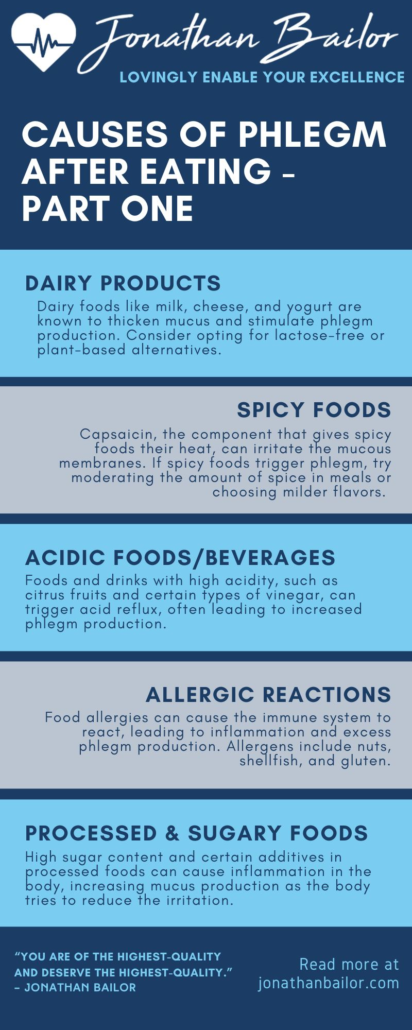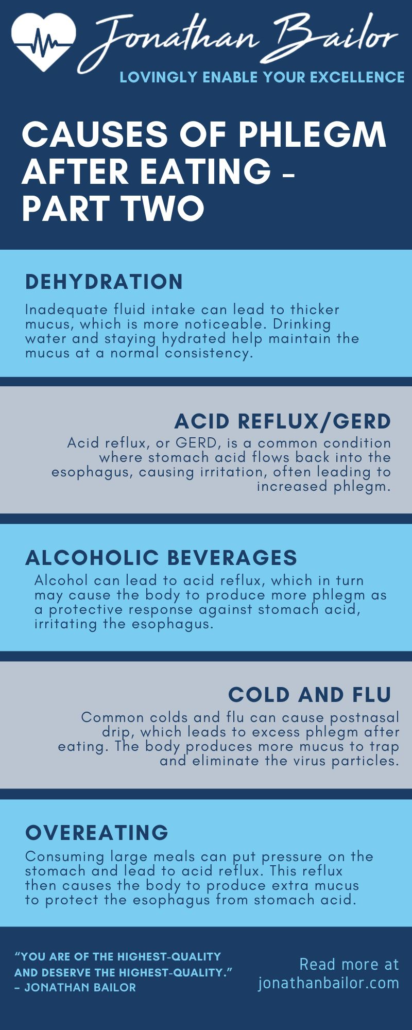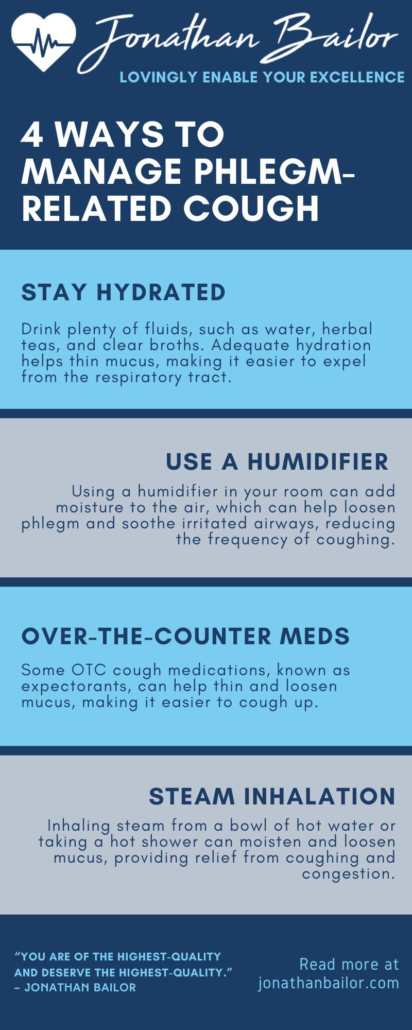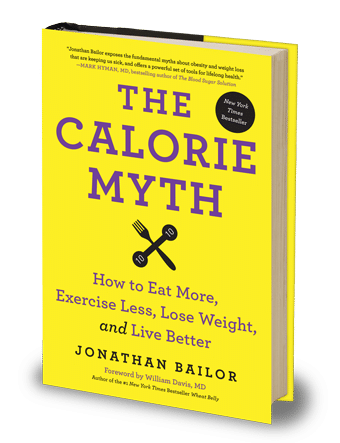Solving the Mystery of Phlegm After Eating: 10 Causes and Easy Solutions
Do you get phlegm after eating? You’re not alone and here are 10 causes with easy solutions! Are you ready to say “goodbye” to experiencing phlegm after eating meals? Read on for an expert analysis of why eating can cause excessive phlegm production, with tips on how to minimize its occurrence, in this cough and phlegm guide with Jonathan Bailor!
Experiencing phlegm after enjoying a meal can be more than just a minor annoyance of throat clearing and coughing after eating; it’s a puzzle many find themselves trying to solve. Excessive phlegm production after eating is not an uncommon experience, but it often leaves many wondering about the causes behind it and, more importantly, how to find relief. This issue transcends age, gender, and lifestyle, making it a universal concern that seeks simple yet effective solutions.
Make sure to read our 14 Evidence-Based Home Remedies For Persistent Cough and 23 Breathing and Other Techniques for Easing Coughing Fits guides next!
While the reasons for phlegm production post-meal can vary, ranging from dietary choices to underlying health conditions to food allergies, understanding these triggers is vital to managing and alleviating the discomfort. Often, it’s the everyday habits or overlooked ingredients in our meals that contribute to this reaction, yet these factors can be easily modified once identified.
This article delves into the various causes behind post-meal phlegm, shedding light on the often-overlooked aspects of diet and lifestyle that could contribute to this issue. It’s not about complex medical jargon or inaccessible solutions; it’s about practical, everyday changes that can make a significant difference.
Whether it’s tweaking the diet, understanding body reactions to certain foods, or adopting simple habits for better digestive health, the focus is on easy-to-implement strategies that offer relief.
Sharing this knowledge is not just about solving a personal health puzzle; it’s about empowering others in their journey toward better health and comfort. Imagine enjoying meals without the worry of phlegm and having the tools to manage it effectively should it occur.
That’s the goal—to turn a common annoyance into a manageable aspect of daily life, using solutions that are as accessible as they are effective.
Understanding the Role of Excess Phlegm in the Body
Phlegm, a substance the body naturally produces, plays a crucial role in the respiratory system. Its primary function is to protect and support our respiratory tract, trapping and eliminating foreign particles like dust, bacteria, and allergens. When the body detects an irritant, phlegm production increases as a defensive mechanism to encapsulate and remove these unwelcome elements.
However, there are times when the body produces excess phlegm, leading to discomfort and annoyance. This overproduction can be the body’s response to a variety of triggers, including upper respiratory infections like the common cold, allergies, or even changes in the environment. Excess phlegm can also be a reaction to certain foods or lifestyle habits. It’s a sign that the body is attempting to protect itself from what it perceives as a threat to its well-being.
Understanding these triggers is vital to managing and reducing the occurrence of excess phlegm. It’s about tuning into the body’s cues and recognizing its way of signaling that something needs attention. By doing so, we can take proactive steps to alleviate this excess production and enhance our overall comfort and health.
Common Culprits: Uncovering the Causes of Phlegm After Eating
Experiencing phlegm after eating can often leave you puzzled about what’s triggering this bodily response. This occurrence isn’t just random; it’s usually a signal from the body reacting to various dietary and lifestyle factors. Identifying these triggers is the first step toward reducing their impact. Here are some common causes of phlegm production following meals, each with its own considerations and solutions.
1. Dairy Products
Dairy foods like milk, cheese, and yogurt are known to thicken mucus and stimulate phlegm production. The proteins found in dairy can cause a histamine-like reaction in some individuals, leading to increased mucus production.
To reduce this effect, consider opting for lactose-free or plant-based alternatives like almond or oat milk. Experimenting with reduced dairy intake can help identify its impact on phlegm production.
2. Spicy Foods
Capsaicin, the component that gives spicy foods their heat, can irritate the mucous membranes. This irritation often results in the body producing more phlegm as a protective response to soothe the lining of the throat and digestive tract.
If spicy foods trigger phlegm, try moderating the amount of spice in meals or choosing milder flavors. Including a balance of cool, soothing foods like yogurt can also help counteract the effects of capsaicin.
3. Acidic Foods and Beverages
Foods and drinks with high acidity, such as citrus fruits and certain types of vinegar, can trigger acid reflux. This reflux often leads to increased phlegm production as the body attempts to neutralize and clear the acid from the throat.
To lessen the impact of acidic foods, combine them with alkaline foods like leafy greens. If acid reflux is a concern, avoid lying down immediately after eating and monitor the portion sizes of acidic foods.
4. Allergic Reactions to Food
Food allergies or sensitivities can cause the immune system to react, leading to inflammation and excess phlegm production. Common allergens include nuts, shellfish, and gluten.
Identifying and avoiding specific food allergens is crucial. Keeping a food diary can help track reactions and pinpoint triggers. Consulting with a healthcare professional for allergy testing may also provide clarity.
5. Processed and Sugary Foods
High sugar content and certain additives in processed foods can cause inflammation in the body. This inflammation often manifests as increased mucus production as the body tries to mitigate the irritation.
Reducing the intake of processed and high-sugar foods can decrease inflammation and mucus production. Focus on a diet rich in whole foods, fruits, and vegetables to maintain a balanced internal environment.

Feeling Better Is Priceless, That's Why We Don't Put A Price On It!
“It’s Like A Free and Medically Valid Version of Noom and Weight Watchers Online”
~ Dr. Doctor Matthew Oleshiak, MD
Click the 'LEARN MORE' button below for free lifetime access to the fast fix program developed by Jonathan and top Ivy League Medical Doctors
LEARN MOREP.S. It's not a free trial. It's not part of the program for free. The entire program is free, forever, for real! No credit card needed.
6. Dehydration
Inadequate fluid intake can lead to thicker mucus, which is more noticeable. Drinking water and staying hydrated help maintain the mucus at a normal consistency, making it less bothersome.
Maintaining hydration by drinking plenty of water throughout the day can help keep mucus thin and less noticeable. Aim for at least 8 glasses of water daily, more if active or in hot climates.
7. Acid Reflux/Gastroesophageal Reflux Disease (GERD)
Acid reflux, or GERD, is a common condition where stomach acid flows back into the esophagus, causing irritation. This irritation often leads to increased phlegm production as the body’s way of protecting and soothing the esophageal lining.
While throat clearing and coughing after meals can signal excess phlegm production, acid reflux includes symptoms like chest tightness, difficulty swallowing, and heartburn. It’s important to note that a variant of GERD called Laryngopharyngeal reflux, also called silent reflux, may display just one symptom — chronic cough.
Avoiding foods and beverages that trigger reflux, such as caffeine, chocolate, and fatty foods, is key. Eating smaller meals and not lying down immediately after eating can also help manage symptoms. If acid reflux is a consistent issue, consulting a healthcare professional for appropriate treatment is advisable.
8. Alcoholic Beverages
Like spicy foods, alcohol can lead to acid reflux, which in turn may cause the body to produce more phlegm as a protective response against stomach acid, irritating the esophagus.
Moderating alcohol consumption, especially in the hours before bedtime, can help manage acid reflux. Opting for lower-alcohol beverages and pairing them with food can also mitigate their impact.
9. Cold and Flu
Common colds and flu can cause postnasal drip, which leads to excess phlegm after eating. The body produces more mucus to trap and eliminate the virus particles.
Practicing good hygiene, getting the flu vaccine, and boosting immunity with a balanced diet and regular exercise can help prevent colds and flu. Using a humidifier and staying hydrated can also reduce postnasal drip.
10. Overeating
Consuming large meals can put pressure on the stomach and lead to acid reflux. This reflux then causes the body to produce extra mucus to protect the esophagus from stomach acid.
Eating smaller, more frequent meals can help prevent overeating and reduce the risk of acid reflux. Chewing food thoroughly and eating slowly can also aid in better digestion and less phlegm production.
Understanding these triggers offers valuable insights into managing and potentially reducing the occurrence of phlegm after eating, leading to greater comfort and a more enjoyable dining experience.

Coughing and Phlegm: Addressing Your Frequently Asked Questions
Q1: Why do I cough more at night or after lying down?
Coughing often intensifies at night or when lying down due to the gravitational shift that affects the movement of the phlegm. In a reclined position, mucus from the nasal passages and sinuses can accumulate in the throat, triggering the cough reflex. To alleviate this, try sleeping with the head elevated and maintaining a well-humidified environment to soothe the throat.
Q2: Is it normal to cough up phlegm every day?
Coughing up phlegm occasionally, especially in the morning, can be normal as the body clears overnight mucus accumulation. However, daily expulsion of phlegm, especially if it changes color, thickness, or volume, could indicate an underlying condition like chronic bronchitis or sinusitis. Consult a healthcare professional if daily phlegm production persists or is accompanied by other symptoms.
Q3: Can certain foods cause an increase in phlegm and coughing?
Yes, certain foods can stimulate an increase in phlegm and subsequent coughing. Dairy products, for instance, can thicken mucus for some individuals. Spicy foods containing capsaicin can irritate the throat and increase mucus production. Observing dietary intake and identifying triggers can help manage phlegm-related coughs.
Q4: What does the color of my phlegm indicate?
The color of phlegm can provide insights into your health. Clear phlegm is usually normal and may increase with a cold or allergies. Yellow or green phlegm could indicate an infection, while brown or red phlegm might signal bleeding in the respiratory tract or irritation from smoking. Persistent changes in phlegm color should be evaluated by a healthcare provider.
Q5: How can I effectively manage a phlegm-related cough?
Effective management of a phlegm-related cough involves addressing the underlying cause and maintaining good respiratory health. Staying hydrated helps thin mucus, making it easier to expel. Using a humidifier can soothe irritated airways. Avoiding irritants like smoke and allergens and incorporating breathing exercises or steam inhalation can also provide relief. If a cough persists or worsens, it’s advisable to seek medical advice for targeted treatment.

Sharing Wellness: A Conclusion to Our Journey Through Understanding Phlegm and Cough
In exploring the nuances of phlegm production and its triggers, we’ve uncovered practical insights into managing this common health concern. From dietary adjustments to lifestyle modifications, each step offers a path to greater comfort and well-being.
As we close this chapter, consider sharing these valuable learnings with friends and family. Whether through social media platforms or a thoughtful email, spreading awareness can empower others in their quest for health. Together, let’s build a community where knowledge leads to action, and action fosters a healthier, happier life for all.
Feeling Better Is Priceless, That's Why We Don't Put A Price On It!
“It’s Like A Free and Medically Valid Version of Noom and Weight Watchers Online”
~ Dr. Doctor Matthew Oleshiak, MD
Click the 'LEARN MORE' button below for free lifetime access to the fast fix program developed by Jonathan and top Ivy League Medical Doctors
LEARN MOREP.S. It's not a free trial. It's not part of the program for free. The entire program is free, forever, for real! No credit card needed.




